How to make a water heated floor under linoleum: design rules and an overview of installation technology
The underfloor heating system creates an atmosphere of coziness and special comfort. In some rooms, such a complex can become the main heating option, allowing you to abandon traditional radiators.
However, before deciding on its arrangement, it is necessary to carry out the calculation of the system, take into account the upcoming operating conditions and a number of parameters. An important factor is the type of flooring. The material affects the heating efficiency and the installation technology of the heating main.
Many people prefer to equip a water heated floor under linoleum - such a coating is notable for its affordability and good performance. We offer to deal with the principle of the system, its components, choose the best connection option and pipe laying scheme.
In addition, we will show you how to calculate a warm floor and pick up pipes, and also describe the step-by-step technology for installing a heating circuit under linoleum. Expert advice will help design and equip a reliable and efficient heating system.
The content of the article:
- The nuances of operating linoleum with VTP
- General principle of the system
- Is it possible to “hook” the system to the central highway?
- Pipe Layout Options
- Calculation of underfloor heating
- Room requirements and pipe selection
- Possible system installation options
- Valuable recommendations from specialists
- Conclusions and useful video on the topic
The nuances of operating linoleum with VTP
Water floors have so "taken root" in cottage towns and private house buildingthat their systems began to be installed in newly built suburban settlements, where special heat exchangers had already been provided for and mounted in advance to connect this design.
The main and significant advantage of this heating system is the economical consumption of thermal energy, the exclusion of exposure to such harmful factors as electromagnetic and electric fields.
The following points are considered to be fundamentally important disadvantages of the installed in the ECP houses:
- dependence on gas or other boiler equipment;
- the complexity of installation work;
- an increase in the height of the floors, which may in some cases be unacceptable;
- risk of water leakage in pipes if installation technology is not followed.
These disadvantages can be dealt with if each stage of the installation of a warm floor is carried out as efficiently as possible.
Owners of private suburban real estate are not very willing to use linoleum as an external floor covering because of erroneous suspicions about its home safety. Linoleum, unlike other coatings, is a rather demanding material for intense heating.
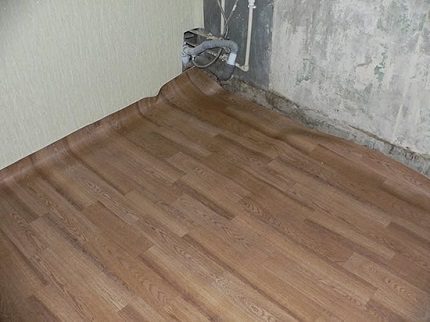
If you follow all the prescribed standards for regulating the temperature of floor heating, then the linoleum in the house will not warp, swell under the influence of excessive heating, and, accordingly, emit harmful substances.
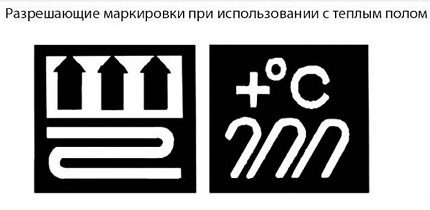
Applying high-quality, certified linoleum for water flooring, maintaining normal heating mode, you will enjoy the comfort of a heated floor. This is the case when linoleum can become no worse than ceramic tile or laminate flooring.
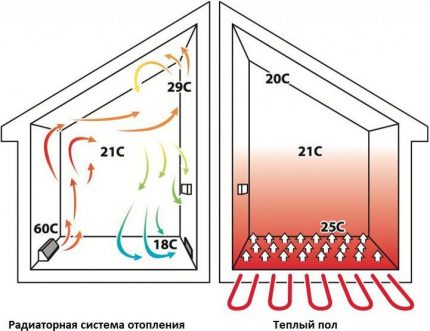
Thanks to modern technologies in the production of floor coverings, you can safely use linoleum as a finishing, finishing material for flooring it on a water floor mounted by you or a construction team.
General principle of the system
The basis of the system of such a room heating system is two-pipe heating circuit, functioning on the principle of forced circulation of water or other coolant. Pipe wiring and collectors will be connected to the devices.
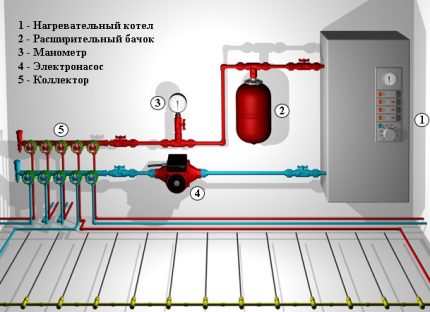
The following important components are laid in the general scheme:
- boiler group - provides uninterrupted circulation through the collectors of hot water;
- return and supply lines for power supply groups "collector + mixing unit”, Distribution manifolds;
- heating fittings;
- supply pipe.
The heart of the heating group is the boiler. Other, equally important components of it are a safety group, an expansion or compensation tank and a pump.
If you briefly describe the principle of the system, it will look like this:
- Heated water comes from the boiler. She gets on a two or 3-way thermostatic valve. As soon as the temperature exceeds a critical value, access for water from the return pipe is opened and the temperature is equalized.
- The thermostatic valve is controlled by a thermostat. The mixed flow enters the thermostat after passing through the circulation pump.
- When the water warms up to the set temperature, the mixture from the return line stops, when changed upwards, it opens again. Thus, the temperature of the water circulating in the system is regulated.
- Directs the coolant along the circuits of the collector or distribution comb. This unit is assigned not only a distribution function, but also the task of collecting and sending the coolant to the return pipe.
By and large, the water heating floor is the same radiator, but located horizontally and protected from operational loads.If there is no control unit, the system will only work if the water temperature in the system does not exceed 50 ° C.
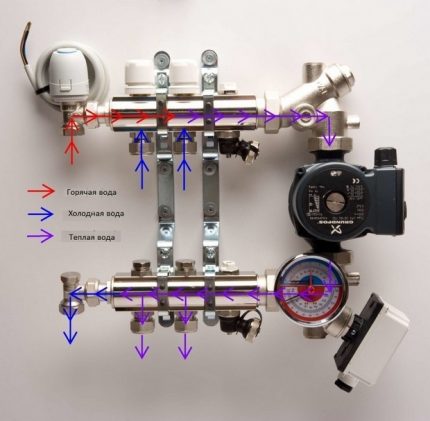
The system itself is not perfect: it has an inertia, heats the room for a relatively long time - from 4 to 6 hours. Difficulties also arise at the design stage, when water floors are the only source of heat.
Installation is not cheap and reduces the height of the rooms due to the fact that the floor rises. The pipe system is not easy to repair.
Is it possible to “hook” the system to the central highway?
This question worries a lot of people. If you answer unequivocally, then it is better not to. For underfloor heating in apartments, electrical systems are usually used due to the frequent occurrence of problems when arranging a water heating option. But in general, it is possible to supply water heating floor from the central highway.
So, without harm to the functioning of central heating, you can install a warm floor in a single apartment according to several correct schemes.
Stationary heat point
A key element of a stationary heating unit is circulation pump. Pipe bends are welded to the riser CH. In this case, the water will have a stable temperature due to the operation of a pre-mounted thermostatic valve.
If this option is selected, it is imperative to protect the circulation pump by installing a pressure or flow control relay.
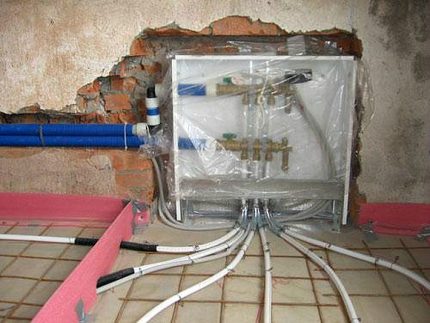

When a thermostat is installed and a laid on thermostat, it will turn off the pump every time the temperature reaches an acceptable minimum - about 20 ° C. Even better controls the system regulator, adjusting the temperature based on the temperature in the room.
Vertical option
If the heating system is designed so that it has a single outlet, the underfloor heating is connected according to the principle of radiators. By choosing this solution, it is possible to provide 2 times the heat than with conventional central heating.
If there are 4 risers in the apartment, two of the water are taken from the central system, and the liquid flows in transit from the remaining ones.
The components of such a scheme are such elements:
- risers;
- balancing valve;
- 3-way valve;
- valve actuator.
Old radiators are dismantled, and instead they are installing a "warm floor" system. This will not affect the hydraulic mode of the system, as balancing valve settings will remain unchanged.
The floor contour is connected in parallel. It is important to take pipes with the same length so as not to adjust the heat exchangers in the next circuit.
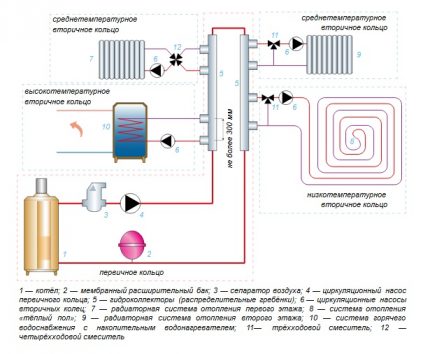
Pipe Layout Options
So, you have decided on the connection method and now is the time to think about designing. There are several schemes for stacking ECPs. You need to choose them carefully - the performance, reliability, cost of the system and how heat is distributed throughout the room depends on it.
Schemes are as follows:
- "The snake."It happens single or double. In the first case, the pipes go along the wall and round off at the end of the trajectory, changing direction and covering the entire area. In the second, the installation scheme is the same, but they lay a pair of pipes parallel to each other at a distance of 3 cm. With this technology, floor surface heating is reduced in stages.
- "The snail." In plan view, the circuit looks like a spiral that closes at the end point. A spiral diagram, the installation of which begins from the depth of the room to its center.
- The combined method. In one area, several methods are used, but the most effective prevails.
Since during the movement through the pipes the water temperature gradually decreases, the choice of one of them determines how evenly the heat will be distributed in the room. The starting point for laying pipes is the wall. Further advance towards the exit or towards the center.
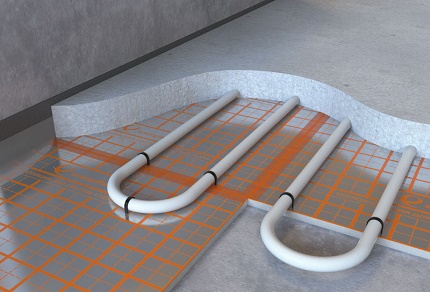
Regardless of the selected scheme, there are several general rules by which pipes are distributed. The first of them is to begin installation from the outer wall. The following requirement concerns the step size - not less than 10 and not more than 30 cm. It is necessary to calculate the hydraulic resistance.

The greater the number of turns the system has, the greater the resistance value. The same thing happens with increasing pipe lengths. If the installation is carried out in a screed, the joining of pipes with the help of couplings cannot be performed.
The following circumstances affect the choice of the laying scheme:
Experienced installers do not recommend laying pipes in those places of the house where plumbing or cabinet furniture will stand.
Calculation of underfloor heating
The required amount of pipe is calculated by the formula:
L = k × S / H,
Where:
- L - length of the water floor;
- S - area covered by the contour;
- k - increasing factor, usually it is taken in the range from 1 to 1.1;
- H - laying step.
To the figure that results, add 4 m, 2 of which will be used to connect a straight pipe, and 2 others will be used to connect to the return manifold.
Knowing the loop pitch, the flow rate of pipes can be taken from the table:
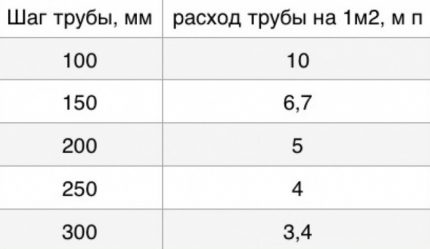
For the effective operation of the system, the maximum possible contour length is of great importance. If it is exceeded, the circuit may cease to function as a result of the occurrence of statistical equilibrium in the pipe.
Professionals recommend choosing a length of not more than 70-80 m for a pipe with a cross section of 1.6 cm. On both sides of the pipe, the floor is heated on both sides by approximately 100 mm. For pipes with a cross section of 2.0 cm, the maximum length is 100-110 m.
If the calculation results in a length exceeding the maximum allowed, the room is divided into 2 or more zones and several similar circuits are mounted. In the latter case, the installation of a manifold cabinet is required.
To perform the calculation of the pump for a warm floor, use the formula:
Q = 0.86P / (t1 - t2),
Where:
- P Is the power of a single circuit in kW;
- t1 and t2 - supply and return temperatures, respectively;
- 0,86 - correction factor for water.
Having calculated each circuit, the results are summarized and get the required performance.
Additional information on the calculation of pipes for underfloor heating is given in this article.
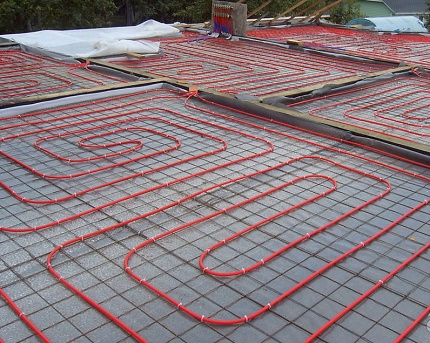
The pressure is calculated by the formula:
H = (R * L + K) / 1000,
Where:
- R - hydraulic resistance;
- L - the length of the contour of the largest length;
- N - pressure
- K- power reserve coefficient.
Choosing a boiler, you should focus on the temperature adjustment range - it should start at 30 ° C. To distribute heat along the circuits, a collector is installed, selected according to the number of circuits. The number of pins on it should ensure the connection of all circuits.
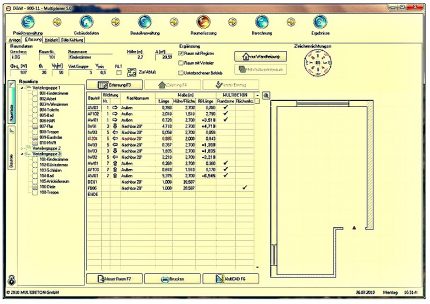
In the collector of the budget type there are shut-off valves, but there are no regulators to configure the system. In equipment belonging to the middle price segment, there are regulators with the help of which they adjust the flow of water in any circuit. The most efficient and expensive collectors are automated.
Here, on each valve there is a servo-drive, mixer units with a two- or 3-way zone valve. In such systems, it is possible to adjust the temperature of the supplied water and mix liquids with different temperatures.
The collector cabinet of the correct size must be selected in accordance with the dimensions of the collector group.
Under it should remain free space necessary for bending pipes. It is installed at a certain distance from the surface of the warm floor. It can be mounted in the wall, but not in the carrier.
Room requirements and pipe selection
Water floors can be laid already in the finished premises.
They must comply with the following principal requirements:
- Given the rather large thickness of the warm floor (8-20 cm), the design height of the ceilings of such premises should allow property owners to install their chosen heating system.
- The height of the doorways is at least 210 cm.
- The total heat loss in the rooms should not exceed 100 W / m2. If they are in fact higher, then you should first think about better insulation of the building, so as not to heat the street in vain.
- The surface of the base is smooth and clean, with irregularities not exceeding 5 mm. Sudden changes can negatively affect the unhindered flow of the coolant in the pipes, theoretically, they can affect the airing of the circuits, increase the hydraulic resistance.
- Plastering and finishing work must be completed in the premises, double-glazed windows are inserted in the window openings.
The choice of pipes is the most important task at the stage of preparation for the installation of a warm water floor. It depends on their characteristics how effectively the floor will give off heat.
As a rule, they acquire one of three types of pipes:
- Copper. An expensive option, but the most durable and trouble-free to operate. An alternative to the copper circuit is stainless steel pipes.
- Metal-plastic. Affordable, high-quality pipes that can hold their shape are easy to install. Usually they choose pipes with a cross section of 1.6 cm. The meter is preliminarily calculated with great accuracy, otherwise the pipe sections will have to be connected, and this is extremely undesirable.
- Polyethylene. With them, a simpler installation of the floor pipeline is possible, cross-linked polyethylene pipes they are not afraid of freezing, are easily repaired. Their minus is that at the moment of exceeding the water temperature they can straighten and violate the integrity of the structure.
Copper pipes - this is the most successful option, because copper is the best conductor and coolant. Copper piping in warm floors guarantees maximum heat transfer to the water circuit. The material will be used for a long time and flawlessly, but it is too expensive, so it is rarely used.
Possible system installation options
Water floor heating without screed
There are several ways to install a warm floor without screed:
- On polystyrene mats. They mount heat distribution plates having grooves into which the pipe circuit is inserted. Substrate options for underfloor heating are described in detail. here.
- The gaps in the wooden floorthat are specially left between the boards.
- Into milled grooves in a wooden base, where heat exchangers and pipes are laid.
Instead of heat exchange plates, you can choose a simpler option - aluminum foil.
The installation technology for a lightweight warm floor is simple, but all the norms must be maintained. Installation malfunctions can cause the finished coating to be torn off in order to eliminate deficiencies.
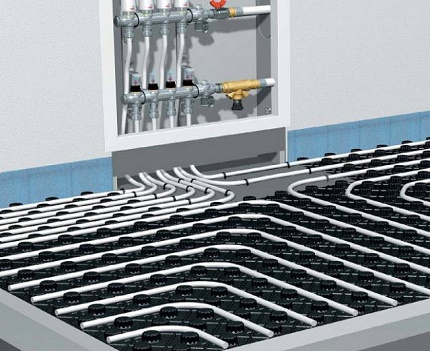
Depending on the area of the premises, materials are selected. For the installation of the circuit, good quality planed boards with a thickness of 4.5 to 5 cm are required. In the boards, using the cutter, select grooves for a specific pipe diameter with the required pitch.
At one of the ends choose a “quarter”. Instead, you can use purchased slats for installation with ready-made recesses. In addition to the grooves in the boards, it is necessary to provide semicircular recesses at the points of the contour pivot.
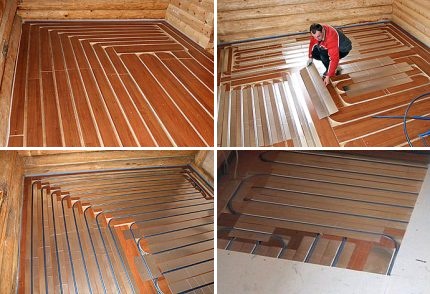
If the warm floor serves only as an addition to the main heating, you can make a laying step of up to 30 cm. If this size is exceeded, both warm and cold sections will be on the floor. When this heating system is the main one, choose a step from 10 to 15 cm. Laying with a smaller step is very difficult to perform.
A timber for logs is prepared on the basis of those considerations that they will be stacked in increments of 50 to 60 cm. In addition to the board and timber, sheets of plywood or OSB 8-10 cm thick are needed, prepared in such a way that they cover the entire area.
It is necessary to purchase foil insulation based on foamed polystyrene with a thickness of 0.5 - 0.6 cm and non-foil insulation made of polyethylene foam with a thickness of 1-1.5 mm in such an amount as to cover the entire surface.
A warm floor, built on polystyrene mats with bosses, can be completed with a dry screed arranged in the form of a flooring, or pour a traditional cement-sand mortar. In the second case, pouring operations are performed in the following order:
Wooden mounting technology
First of all, you need to prepare the existing wooden coating. All gaps and gaps eliminate. A new floor, not yet stained and not soaked with drying oil, is covered with an antiseptic. Further, on a prepared base, a foil insulation made of foamed polyethylene is spread.
The stripes are laid end-to-end with a foil layer. Using a stapler, the coating is attached to the boards. All seams are sealed with foil tape. Logs are fixed perpendicularly to the board base, having previously set them in level.
Lay boards on the logs. At the wall along which the installation of cranes is planned, a groove is cut out for the location of the pipe supplying the coolant and the return flow. Using screws, fasten the boards to the logs.
They install nozzles with cranes - direct and reverse, then install a bypass equipped with a valve between them. Such a solution will make it possible, if necessary, to disconnect a separate circuit, leaving the system operable, as well as perform circuit balancing.
Before laying pipes, all recesses are free from dust and sawdust with a vacuum cleaner and strips of 25 cm wide foil are prepared.
The foil strips are laid out on top of the recesses to place the pipes in the direction from one to the other wall.Pipes are laid on the foil and recessed into grooves. The foil will heat up and reflect heat, directing it toward the room. The pipe is connected to the fitting of the supply pipe.
Foil ends protruding beyond the groove are folded, bending them so that they lie on the previous board, then they are fixed with a stapler. The pipe is fixed to the floor along the entire contour using plates - metal or plastic, placing them at a distance of 60 to 70 cm from each other.
Particular attention should be paid to those places where the pipe makes a turn.
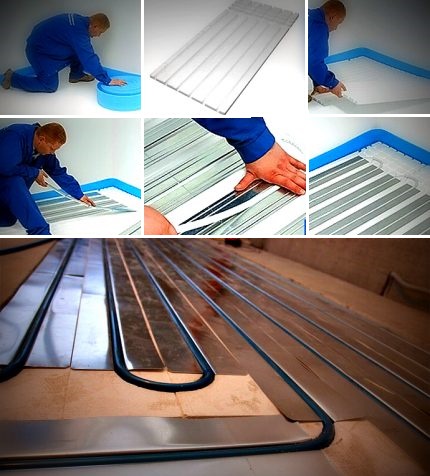
The entry and exit node will be above the floor, so it should have an aesthetic appearance. You cannot deepen it into the wall, but you can build a beautiful box with a door, which makes it possible to freely use the adjusting cranes.
After performing these operations, the contour of the warm floor is checked for leaks, for which water is launched into it, and an excess pressure is created that exceeds the working one and a half times.
If no leaks are observed, proceed to the next installation stage: the entire surface is covered with thermal insulation, blocking the wall material to a height of 10 to 15 cm. This will protect the coolant from rapid temperature loss.
Then lay the plywood. The ends of the sheets should not fall on the pipes, as when fixing the material with self-tapping screws, they can be damaged.
Having completed the installation of plywood sheets, the entire surface is cycled. Seams are sealed with sealant or epoxy mixed with sawdust. Next, the ends of the foil protruding beyond the plywood are cut off and the seal is cleaned if it protrudes above the floor. They spread linoleum, cut it so that the edges of the canvas covered the walls of a centimeter by 3.5.
When the linoleum settles down and recovers during the day, and sometimes more, cut off the excess by applying a metal ruler. A gap of 0.8 to 1 cm is left between the linoleum and the wall. After trimming, it is advisable to leave the coating in this position for another 24 hours and then fix it with glue, adhesive tape or other means.
Concrete screed water floor
Pie obtained by wet technology or by laying in a screed, includes several layers. The first is the insulation, then the net or tape - the so-called fixing system, then the pipeline and the screed itself. Completes all flooring.
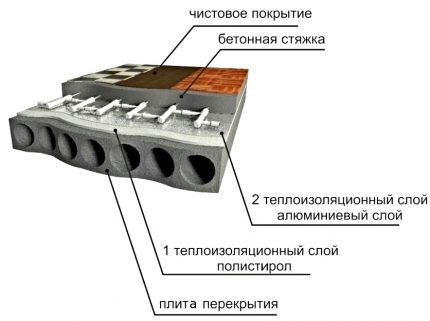
In apartment buildings, where there is a danger of flooding of the lower rooms, a waterproofing layer is also placed under the insulation.
Before starting installation work, select a location for the collector box. It places, not quite aesthetically pleasing valves, pipes, drainage bends. The assortment of cabinets is very large, so you can make a choice according to dimensions and other important parameters.
The installation process itself consists of the following steps:
- Clean, smooth the surface. Check the level of horizontalness. A difference of maximum 10 mm is allowed, if more, alignment is carried out.
- Lay a waterproofing film.
- Along the perimeter of the room, edge insulation in the form of a damper tape is laid and fastened.
- Lay out the insulation with a layer of 10 to 50 mm.
- A vapor insulating layer is placed on top.
- Carry out a mesh reinforcement with cells from 150 to 200 mm. At this stage, there is one interesting nuance: most often the reinforcing layer is spread before the installation of pipes, but experts recommend doing this after so that the load on the pipeline is distributed evenly.
- Proceed with the installation of the floor, for which:
- connect the pipe to the outlet pipe of the feed manifold;
- fix the pipes to the reinforcing mesh with a step of about 100 cm, using special clips, ties or straps, and after installation is complete, connect the pipe to the outlet on the comb.
- They test their performance by turning on the floor for several hours. A well-executed installation is evidenced by a decrease in pressure of approximately 003 MPa / h. at approximately the same water temperature.
- The screed is poured taking into account the fact that it should rise 20-30 mm above the reinforcing layer or pipes.
- They put a layer of sound insulation and coating, but only after 30 days, when the screed is guaranteed to dry in natural conditions.
In the process of installing a water floor heating system, the standard steps are performed:
Now everything is the same, only in more detail.
Stage 1: waterproofing the base
Initial actions are to form a waterproofing layer, which is laid under the insulation. It is possible to lay 2 waterproofing layers (on both sides of the insulation). The second option is more preferable.
Stacked in 2 layers, the film will not allow cement milk from the screed to penetrate between the joints of the insulation, and will restrain moisture coming from below.
Waterproofing material can be any of the materials offered by the market. The most affordable and popular is considered ordinary plastic film.
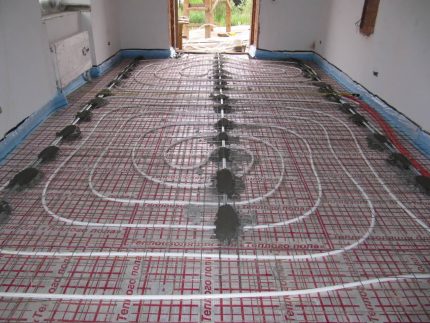
Film covers the base of the floor. At the joints, fragments are placed inoverlap about 15-20 cm, for better sealing glued with tape. In that case, if the film will be fixed to the bottom of the insulation, then the pipes on the warm floor can be mounted directly on the insulation sheets.
Waterproofing, laid on top of the insulation, will require installation of the mounting grid, on which the pipes of the warm floor will be fixed. If you will use Eps as a heater, the flooring of the waterproofing layer can be excluded from installation.
Stage 2: laying the damper tape
Damper tape is an indispensable element for preparing the base of the floor for concrete screed. The linear expansion of concrete when it is heated to + 40 ° C is 0.5 mm per 1 m2. The tape laid around the perimeter of the room will become an obstacle to the negative impact of such a factor and will prevent possible cracks in the screed body.
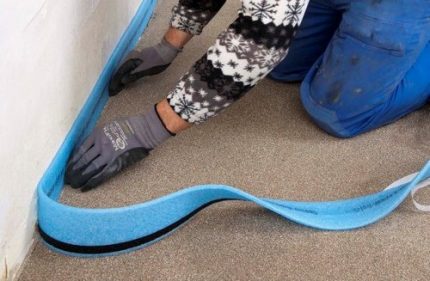
In the budget option, you can use strips of foam rubber or improvised heat-insulating materials with a thickness of up to 2 cm. Such strips must be glued to double-sided tape or screwed with screws, screws. Subsequently, excess damper tape should be carefully cut with a knife.
If the room has a sufficiently large floor area or non-standard shape, then it must be divided into zones of rectangular or square shape. It is convenient for the distribution of deformation gaps between them and the laying of expansion joints. Incorrect clearances will cause the screed to break.
Here it is required to lay the damper tape around the perimeter of the seams, at the place of which the reinforcing mesh will be separated. At its base, the deformation gap should be 10 mm thick, and its upper part should be treated with sealant.
If the pipes are laid along the screed in expansion joints, they must be placed in the corrugation, 50 cm in each direction. This is a prescription of building rules SP 41-102-98.
Stage 3: laying of insulating material
The next operation is to lay the insulation. The construction market is saturated with a huge variety of options.
The most popular and inexpensive option is the popular 10 cm thick sheet polystyrene foam. It has low thermal conductivity and high strength, is not afraid of moisture, which it does not absorb at all. There are special grooves on the side surfaces of the material.
A more expensive option is a functional profile mats.
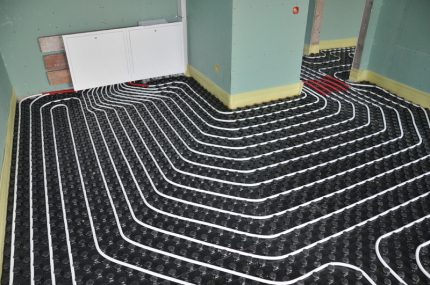
These materials are designed to prevent the passage of heat from the pipes down to the ground, and to direct it up to the room of the house.
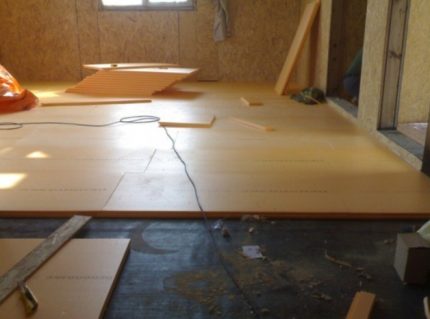
In the event that you plan to place a water-based floor heating above the basement of the house, then the insulation must be laid in a thickness of at least 50 mm.
The insulation is laid on the floors so that the joints between the sheets are carefully shifted together. In the installation of a warm water floor, the insulation refers to the obligatory element of the preparatory base for the finishing screed.
It is imperative that you securely fasten the slabs. Eps to the rough foundation, otherwise they will float when pouring the concrete screed. An ideal choice of fastening is dish-shaped dowels, with the help of which it is necessary to fasten the insulating plates in the joints and in the center.
Stage 4: reinforcing and fastening pipes under the screed
The first layer of reinforcing mesh is laid on sheets of insulation. The grid in this case is used as a basis for attaching water circuits and for the sequential distribution of heat over the entire surface of the future underfloor heating. Pieces of mesh are tied with wire, then with the help of nylon clamps the pipes are attached to the mesh web.
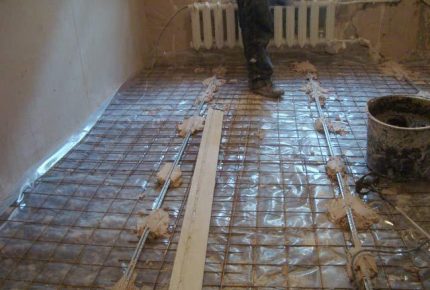
The metal mesh for reinforcement can be replaced with plastic. It reinforces the screed well, saving it from dangerous cracking. Laying such material is quite simple.Plastic mesh is sold in rolls, its price is not high, with it pipe damage is absolutely excluded.
After the reinforcing mesh is laid, the question will arise about the protection of pipes. When you move around a metal grid, you can damage the pipes and the grid itself, so it is recommended to walk only on pre-laid boards or pieces of plywood.
In construction practice, there is a competent solution, applying which when installing a water floor, you will not allow potential damage to the pipes at the time of pouring the concrete screed.
It is necessary to adhere to the following sequence of work:
- A cement mortar is prepared, at the rate of 1 part of cement M400 + 3 parts of sand.
- During the installation of reinforcement, blotches are formed from the solution, they should partially protrude beyond the edges of the mesh, by about 2 cm.
- "Lyachts"Put with a frequency of 30-50 cm, this will then allow you to lay on them boards, other improvised material and safely move over the entire area of the fill.
An additional plus of this solution is mesh fixation. While workers walk on the floor, it bends, this can lead to damage to the welds.
Stage 5: laying the contours of a warm water floor
As we wrote above, the arsenal of modern methods for installing a water floor contains 2 popular schemes pipe layingthat are used in practice:
- "Snake". Simpler wiring diagram. Its disadvantage is that at the beginning and end of the floor, a temperature difference of 5 to 10 ° C will be felt. Water, passing the way from the supply collector to the return, begins to cool.
- "Spiral" or "snail". The scheme is quite complicated to implement, but with it t ̊ of the entire floor will be the same, since the supply and return will go together. In 90% of installation cases, specialists use this method of laying pipes.
There are combined pipe laying methods. In particular, the extreme zones can be laid with a “snake”, and the central part with a “snail”.
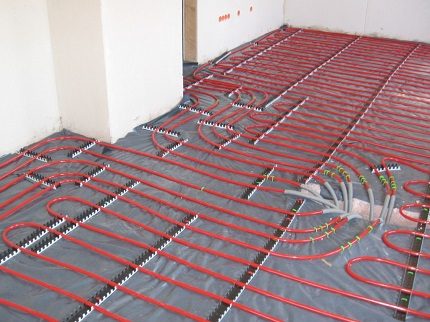
Each of the above methods of laying pipes allows you to apply a variable pitch of laying. This is such a method, when the pitch will be 100-150 mm along the edges, and 200-300 mm in the center of the room. That is, in one room you can make more intense heating of the edges of the room.
Stage 6: arrangement of screed
For pouring screeds, a concrete mortar of the M-300 brand and more is chosen.
The composition of the solution M-300:
- cement, M-400;
- sand;
- crushed stone of fraction 5 * 20.
The working proportion of the solution is as follows: C / P / SC (kg) = 1 / 1.9 / 3.7.
The screed should rise 3-4 cm above the pipes so that the thermal energy of the warm water floor spreads evenly throughout the entire floor area.
The screed must be filled after installation work to install all the circuits and conduct mandatory hydraulic tests. If the thickness of the screed is more than 15 cm, then an additional recalculation of the thermal regime of the water floor will be required.
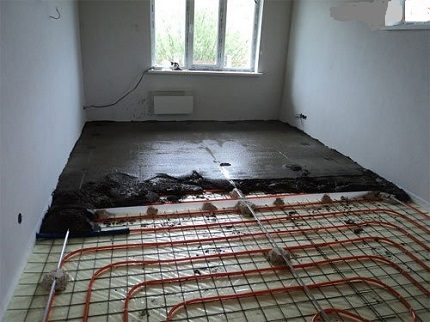
If you have done all the operations correctly, then a well-mixed concrete mortar for screed will not release water and exfoliate. At an air temperature of + 20 ° С, the screed begins to “set” after 4 hours.
After three days after pouring, the screed will gain only half its strength, it will finally harden only after 28 days. The underfloor heating system cannot be turned on until this point. Linoleum should be laid after full readiness.
Valuable recommendations from specialists
When connecting a warm floor to the central heating, some points are very important. Experienced craftsmen advise to pay attention to them.Any connection to the central heating system provides for fastening to the end input of the comb using fittings. The screed must be made as thin as possible and it must be reinforced.
After a trial run, a complete warm-up of the system occurs in 2 days. When passing through walls, use corrugated pipes. The distance from the pipes to the top of the screed is a minimum of 30 mm. You should never use the coolant coming directly from the central heating system, the hydraulics of the house can suffer from this significantly.

If the underfloor heating is connected to an electric boiler, the batteries can be connected directly to the underfloor heating system, and each circuit can be integrated into a single unit through a collector.
Since in the central heating system the pressure reaches 16 atm. This point should be taken into account when selecting structural elements - basically they are designed for 1-2.5 units.
You need to choose a scheme taking into account the area of the apartment. If it is more than 30 m², it is better to connect to different collectors.
The specifics of arranging a warm water floor on different bases are described in the articles:
- How to make a warm floor under linoleum on a concrete floor: detailed instructions
- Heated floor under linoleum on a wooden floor: step-by-step installation instruction
Conclusions and useful video on the topic
After watching this video, you will learn the basic principles of installing a water "warm" floor and you can do it yourself:
Professional recommendations for choosing pipes:
Nuances of installation using a collector circuit:
To independently create a warm floor with water heating, you need to arm yourself with patience and high-quality building materials, as well as certified equipment. Configure the balancing valves, the installation of the boiler and pump to experienced specialists.
The main advantage of a "warm" floor is the cost-effectiveness of this system. In addition to reducing the amount in heating bills, the house will always have a comfortable atmosphere. The process itself is not very complicated, and any home craftsman can master it.
Is there anything to supplement, or have questions about arranging a water heated floor under linoleum? Please leave comments on the publication. The contact form is located in the lower block.

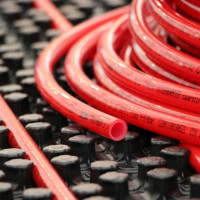 How to make a water-heated floor with your own hands: a step-by-step guide from design to assembly
How to make a water-heated floor with your own hands: a step-by-step guide from design to assembly 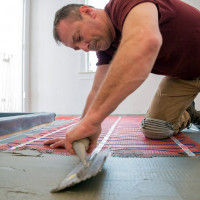 How to make a warm floor under linoleum on a concrete floor: detailed instructions
How to make a warm floor under linoleum on a concrete floor: detailed instructions 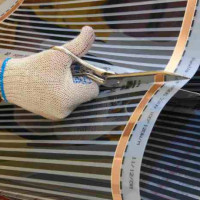 How to make a film underfloor heating under linoleum: instructions for laying an infrared heating system
How to make a film underfloor heating under linoleum: instructions for laying an infrared heating system 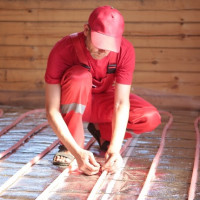 Warm water floor in a private house: diagrams, device rules + installation instruction
Warm water floor in a private house: diagrams, device rules + installation instruction 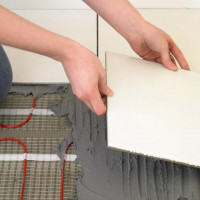 How to make a warm floor under the tile: laying rules + installation guide
How to make a warm floor under the tile: laying rules + installation guide 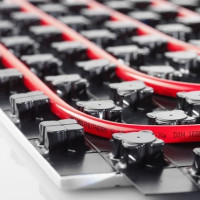 Underfloor underfloor underfloor heating: types, features of choice, laying rules
Underfloor underfloor underfloor heating: types, features of choice, laying rules  How much does it cost to connect gas to a private house: the price of organizing gas supply
How much does it cost to connect gas to a private house: the price of organizing gas supply  The best washing machines with dryer: model rating and customer tips
The best washing machines with dryer: model rating and customer tips  What is the color temperature of light and the nuances of choosing the temperature of the lamps to suit your needs
What is the color temperature of light and the nuances of choosing the temperature of the lamps to suit your needs  Replacement of a geyser in an apartment: replacement paperwork + basic norms and requirements
Replacement of a geyser in an apartment: replacement paperwork + basic norms and requirements
It is written, of course, in a lot and in detail, but I ask for specific advice. It is required to make a “warm floor” in the children's room in the entertainment center. The area is 40 m2, there is central heating, the budget is limited, but I want to do it with high quality. Is it worth it to contact the central heating or still put the boiler, as with a coupler in this case - is it necessary or not? Well, the styling scheme, otherwise each master advises us to get more money out.
Maxim, a concrete answer can only be given on the spot; you have written too few introductory notes. In general, I’ll tell you this: the installation of a water heated floor is not cheap, even at the stage of obtaining documents you will have to spend money.
Combining “quality” and “limited budget” is difficult. On 40m2 you will need to put a collector, and make several circuits for uniform heating.Estimates for the pipe alone will be impressive. Not to mention the pump, automation, mats, screed, etc. You can, of course, save on materials, recruit China, hire easier installers, and all that. But it is later!
First you need to find out whether it is possible to connect to the central heating center, or the technical specifications do not allow it. And as for the installation of “your boiler”, this is also not done without permission, will the gas office give you the go-ahead? Start by getting permissions.
We just chose for ourselves a water heated floor in the house under linoleum based on considerations of economy. I can’t say that it’s cold in our house, they did more of a warm floor for the comfort of a child who plays and crawls - and that's all on the floor. We did not regret that we chose this system - there is a gas boiler, gas consumption is not much more. Everything was mounted strictly according to the norms, linoleum for 2 years did not swell, there was no smell of an outsider in the house. But we have linoleum of good quality and high density.
I bought a gas boiler with an internal combustion chamber and a pump that is suitable for underfloor heating. I think to use metal-plastic pipes, they seem to bend well, and are durable, I have already dealt with them. How long will the connections last? Or, after all, do not connect the pipes under the screed, but bend to the minimum step so that they do not burst? Maybe there is a more acceptable option?